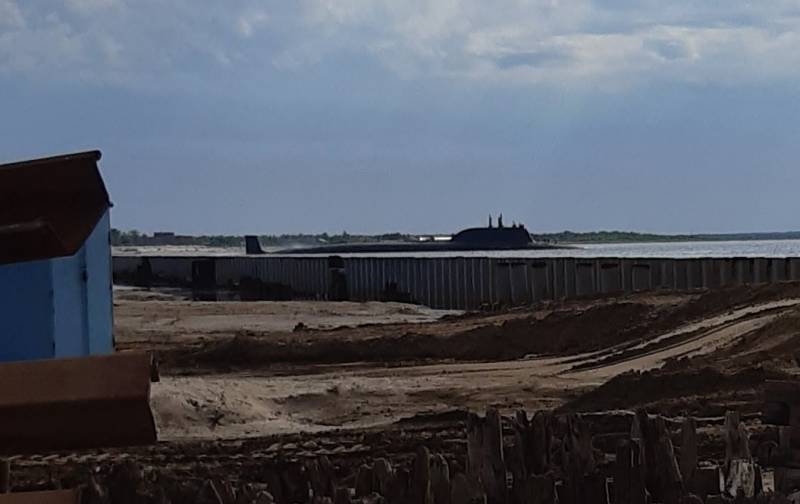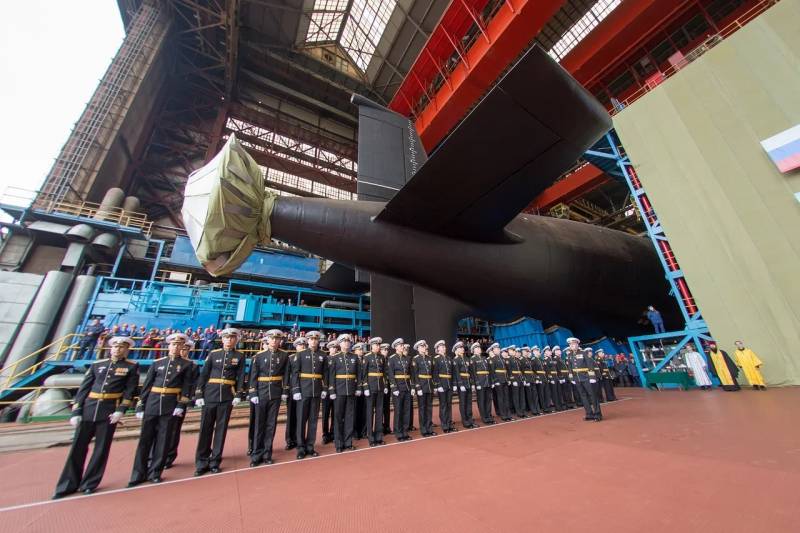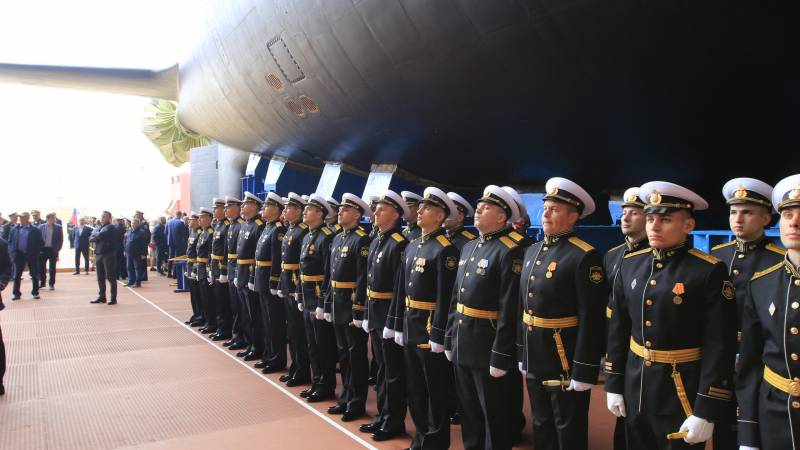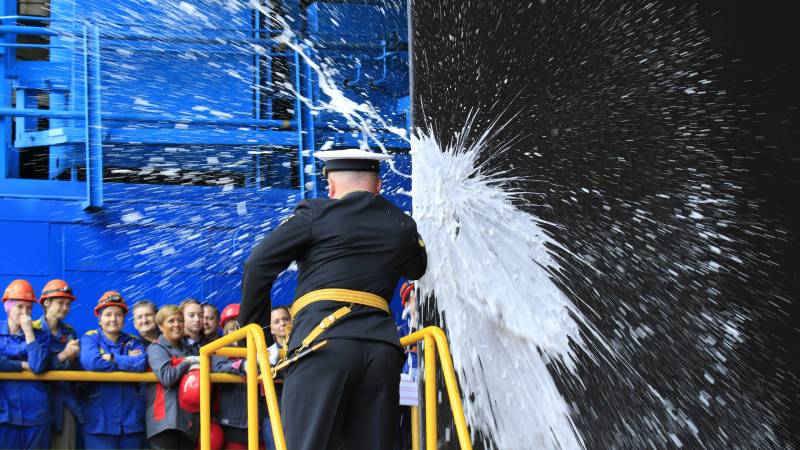Nuclear submarine "Krasnoyarsk" goes to the test
Recently, sea trials of another nuclear submarine pr. 885M "Ash-M" began. The submarine cruiser K-571 Krasnoyarsk went to sea for the first time, and now it has to confirm the design characteristics and demonstrate all its capabilities. The tests will take the next few months, and at the end of the year the submarine can replenish the composition fleet.
Work in progress
The new submarine cruiser Krasnoyarsk was built according to the modernized project 885M and is its second serial representative - after the lead ship K-561 Kazan and the first serial K-573 Novosibirsk, which have already been accepted into the Navy. However, it is not the last in the series. The following five Yasen-M submarines are currently at various stages of construction.
The construction of Krasnoyarsk was carried out at the Northern Machine-Building Enterprise (Sevmash) in accordance with the state contract issued by the United Shipbuilding Corporation in November 2011. This document stipulated the construction of the first five serial cruisers pr. 885M. The first of these was supposed to be Novosibirsk, laid down in July 2013 and handed over to the customer last December.
In 2013-14 Sevmash carried out preparations for the construction of the second serial nuclear submarine of a new project, and on July 27, 2014, the official laying ceremony of the future Krasnoyarsk took place. In 2015-16 the formation of a strong hull was completed and the construction of other structural elements was carried out, and the necessary equipment was mounted in parallel. At the beginning of 2017, it became known that the robust hull was ready and had passed hydraulic tests.
Construction took a few more years and was completed about a year ago. On July 30, 2021, the cruiser was taken out of the slipway into the loading pool of the enterprise. Then he was transferred to one of the berths for follow-up activities. Soon the mooring tests began, which preceded the full-fledged exits to the sea. Against the background of these events, there were reports according to which the Krasnoyarsk would complete the tests and join the fleet by the end of 2022.
First time at sea
On June 27, the TASS agency, citing its source in the shipbuilding industry, reported that on the eve of the Krasnoyarsk nuclear submarine, it first went to sea for factory sea trials. Soon, photographs of a submarine leaving Severodvinsk appeared on specialized resources.
According to TASS, sea trials began on June 26 and are being carried out at the White Sea ranges. During these events, the crew will check the operation of on-board equipment and various systems. It is necessary to determine the seaworthiness and operational qualities of the submarine, as well as to confirm their compliance with the project.
After the completion of the factory sea trials, the submarine is waiting for the state ones. At this stage, Krasnoyarsk will again confirm all the main characteristics, and in addition, a practical test of weapons will take place. At the same time, the timing of the start and conduct of state tests, their program, etc. are not specified. It is likely that the shipbuilders and the Navy will meet the previously announced deadlines, and by the end of the year the submarine fleet will be replenished with a new pennant.
The technical component
The cruiser K-571 "Krasnoyarsk" was built according to the modernized project "Ash-M". It is a multi-purpose nuclear submarine with mine-torpedo and missile weapons, capable of finding and attacking underwater, surface and coastal targets.
The submarine is being built according to a one and a half hull scheme. The light hull is used only in the bow and above the missile launchers in the central part of the ship. The length of such a submarine is 130 m with a maximum width of 13 m. The underwater displacement is more than 13 thousand tons.
Nuclear submarines pr. 885M are equipped with a nuclear power plant based on the OK-650V reactor with a thermal power of 190 MW. Such a reactor is capable of operating without fuel replacement for up to 25-30 years, during almost the entire service life of the submarine. Propulsion is provided by the main turbo gear unit and an electric motor connected to a single propeller. The maximum speed under water exceeds 30 knots, the range is virtually unlimited.
The Yasen-M project is distinguished by a high degree of automation, which made it possible to reduce the crew to 64 people. All systems and units are controlled by the Okrug combat information and control system. The CIUS integrates navigation and communication tools, as well as weapons systems. The main means of illuminating the situation is the MGK-600 Irtysh-Amphora hydroacoustic complex with a large-sized spherical antenna under the forward light body. Additional HAC antennas are placed on the sides of the robust hull.
"Krasnoyarsk", like other "Ash", carries mine-torpedo and missile weapons to hit a wide range of targets. In the central part of the hull are 533-mm torpedo tubes, five on each side. With their help, the submarine can use all current types of torpedoes and mines. Ammunition - 30 torpedoes.
Behind the felling fence there are eight silo launchers for missiles. Each installation can accommodate up to four Onyx anti-ship missiles or five Caliber. Measures are being taken to equip submarines with new hypersonic Zircons. In addition, there are defensive missile weapons in the form of portable complexes "Igla" or "Verba".
Future service
According to known data, the new Krasnoyarsk nuclear submarine is intended for the Pacific Fleet. The inter-fleet transition to a permanent duty station will take place next year - after testing, signing an acceptance certificate and carrying out the necessary preparatory measures. Arriving at the port of Vilyuchinsk, Krasnoyarsk will begin full-fledged service as part of the 10th submarine division.
After being accepted into service, the Krasnoyarsk will become the second new-generation multi-purpose submarine in the Pacific Fleet. The first "Ash" in the Pacific recently became "Novosibirsk", adopted by the Ministry of Defense in December last year. The renewal of the submarine forces will not end there: in 2025 and later, the Pacific Fleet will receive two more multi-purpose nuclear submarines, pr. 885M. It is assumed that these will be the Perm and Vladivostok ships laid down in recent years.
At the moment, the Pacific Fleet has only five multi-purpose nuclear submarines, Project 949A Antey, with cruise missiles on board. Two of them are now undergoing repairs and modernization with the replacement of equipment and the installation of new weapons. Their return to service is expected in 2022-25. The Pacific Fleet also has several submarines, project 971, with mine and torpedo weapons, some of which are also under repair.
The new "Yaseni-M" will have to supplement the existing submarines of the "949A" and "971" projects, improving the quantitative and qualitative indicators of the submarine forces of the Pacific Fleet. In the medium term, the existing ships of old projects, despite all the updates, will face the problem of final moral and physical obsolescence, because of which they will have to be written off. By this time, the Pacific Fleet will have up to four modern nuclear submarines, project 885, which will keep the combat qualities of the submarine forces at the required level.
Having old and new ships of three types and a number of modifications, the 10th submarine division will be able to solve a wide range of tasks. Its ships will conduct patrols and search for various targets, using torpedo or missile weapons if necessary. Despite the solid average age of the submarines, determined by older pennants, the division will be an effective and combat-ready unit.
In general, positive results are expected, but there are some difficulties. The main thing is connected with the pace of construction of new ships. So, a little more than eight years have passed from the laying of the "Novosibirsk" to delivery to the customer. The new Krasnoyarsk, apparently, will also meet these deadlines. Such a work schedule takes into account the needs of the Ministry of Defense and the capabilities of industry, but limits the pace of re-equipment of the fleet. However, negative consequences can be eliminated through the competent preparation of plans for construction, modernization, deployment, etc.
In the process of modernization
Thus, the development of the Russian submarine fleet continues and shows important results. Not so long ago, several types of newly built submarines were accepted into the Navy, and now another missile cruiser is entering sea trials. The upcoming events will take several months, and Krasnoyarsk has every chance of becoming a New Year's gift for the Pacific Fleet.
In general, the observed processes show that our shipbuilding has reached the required pace and is ready to fulfill the orders of the Ministry of Defense in full and on time. Accordingly, there is no doubt that by 2027-28. The Russian Navy will receive all the planned nine nuclear submarines of project 885M, and four of them will timely strengthen the defense in the Pacific direction.




Information